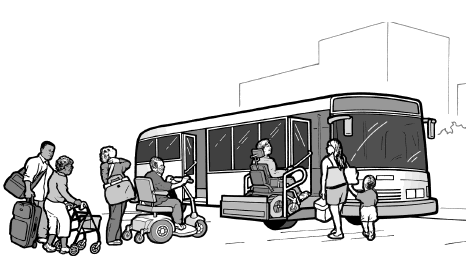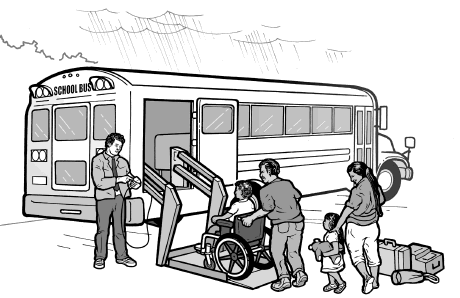An ADA Guide for Local Governments: Making Community Emergency Preparedness and Response Programs Accessible to People with Disabilities
EVACUATION
Individuals with disabilities will face a variety of challenges in evacuating, depending on the nature of the emergency. People with a mobility disability may need assistance leaving a building without a working elevator. Individuals who are blind or who have limited vision may no longer be able to independently use traditional orientation and navigation methods. An individual who is deaf may be trapped somewhere unable to communicate with anyone because the only communication device relies on voice. Procedures should be in place to ensure that people with disabilities can evacuate the physical area in a variety of conditions and with or without assistance.
Action Steps: Evacuation of People with Disabilities
Adopt policies to ensure that your community evacuation plans enable people with disabilities, including those who have mobility, vision, hearing, or cognitive disabilities, mental illness, or other disabilities, to safely self-evacuate or to be evacuated by others. Some communities are instituting voluntary, confidential registries of persons with disabilities who may need individualized evacuation assistance or notification. If you adopt or maintain such a registry, have procedures in place to ensure its voluntariness, guarantee confidentiality controls, and develop a process to update the registry. Also consider how best to publicize its availability. Whether or not a registry is used, your plan should address accessible transportation needs for people who use wheelchairs, scooters, or other mobility aids as well as people who are blind or who have low vision.

A transit bus equipped with a wheelchair lift is used to evacuate individuals and families.
Both public and private transportation may be disrupted due to overcrowding, because of blocked streets and sidewalks, or because the system is not functioning at all. The movement of people during an evacuation is critical, but many people with disabilities cannot use traditional, inaccessible transportation.
Action Steps: Evacuation with Accessible Vehicles
Identify accessible modes of transportation that may be available to help evacuate people with disabilities during an emergency. For instance, some communities have used lift-equipped school or transit buses to evacuate people who use wheelchairs during floods.

A lift-equipped school bus is used to evacuate an individual using a wheelchair and her family.

User Comments/Questions
Add Comment/Question